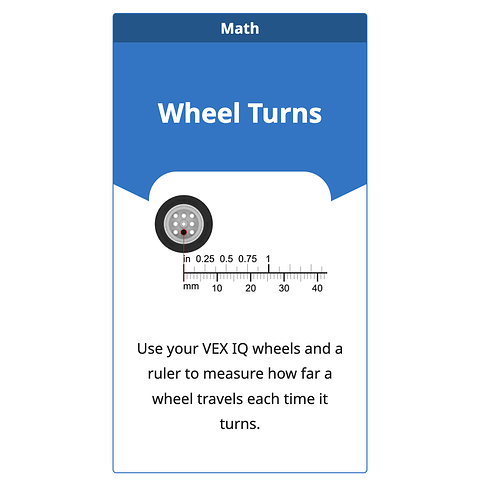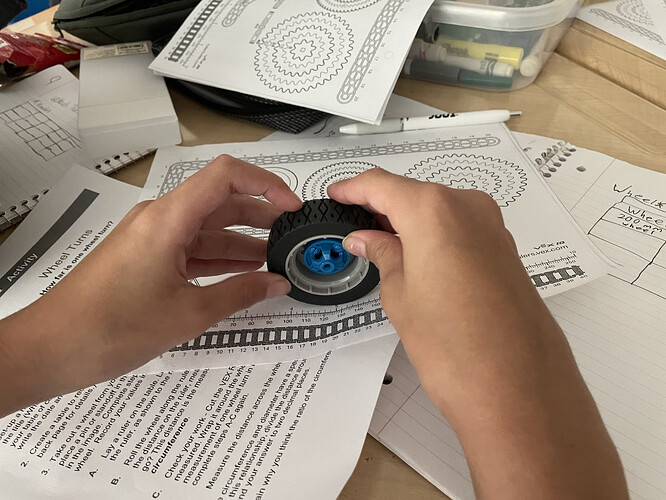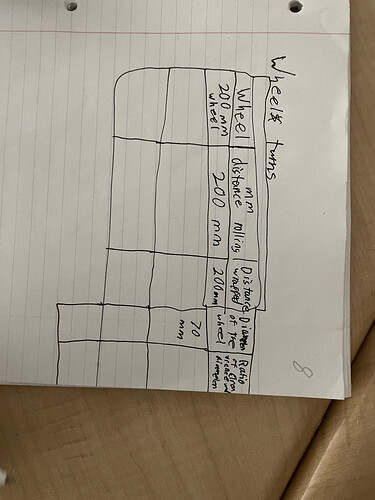Hello everyone! I just wanted to let you know of a brand new IQ Activity that we just published called Wheel Turns!
The purpose of the activity is to use your VEX IQ wheels and a ruler to measure how far a wheel travels each time it turns. This is a great way for students to conceptually understand circumference.
Students are also asked in this activity to physically measure the circumference of an IQ wheel and then asked to use a formula to calculate circumference and compare the values (they should be the same, but probably slightly off if there were measurement or rounding discrepancies). This is also a great moment to talk about how using a formula can produce more accurate and precise calculations (as opposed to measuring by hand, which could have human error).
I know for me as a former high school and collegiate math teacher, students are asked to use formulas all the time but have no idea what the formula means, how it works, and sometimes even what the variables within the formula are representing. Using VEX IQ, students are able to interact physically with circumference and make a very abstract concept, tangible.
There is also research to back the assertion that making mathematics visual is important for learning, especially when studying the brain.
Boaler, J., Chen, L., Williams, C., & Cordero, M. (2016). Seeing as Understanding: The Importance of Visual Mathematics for our Brain and Learning. Journal of Applied & Computational Mathematics 5 (5)
I’m so excited for you to try this activity with your students! 
3 Likes
I just passed this activity off to our VEX IQ 6th Grade Math teachers at the Middle School. Can’t wait to see how it goes! I’ll keep you posted.
2 Likes
Awesome @Tina_Dietrich I’m so glad to hear that! Yes please keep me posted 
If they have any feedback on any other math concepts that they feel are hard for students to understand, I would also like to know that so we can come up with other materials to help students learn these concepts using VEX!
2 Likes
We are incorporating VEX into our 6th grade math class every day. I’d love to send you a list of what they cover throughout the year and see what you come up with!
1 Like
For sure that would be helpful! Any feedback from the math teachers on VEX being incorporated into their classrooms will also be extremely helpful 
1 Like
Here’s the list of math topics our 6th grade math class teaches. Any activities we could use VEX related would be helpful.
-
ratios and rates
-
fractions, decimals, precents
-
fraction and multi-digit computation
-
integers, rational numbers, coordinate planes
-
equations and inequalities
-
relationships between 2 variables
-
numerical and algebraic equations
-
volume and surface area
-
statistical measures and displays
-
area
2 Likes
@Tina_Dietrich I wanted to share a couple of ideas that I already know of that could be helpful for the Math teachers:
I would also suggest they watch this video that I did as a previous Live Session on Math and Robotics, have some great math concepts in there!
These are just a few I know of off of the top of my head, let me know what you think of these! 
The V5 links do not work. They tell me the page does not exist or it is private. I really was interested in the first one right now. The math teacher I mention below added these concepts into the IQ activity. The video link takes me to the live session page but does not show me any specific video. All the rest I can open and will take a look soon. One of my math teachers adapted the wheel turn activity to fit his class. I will upload his activity with some pics. I am going to see this in action tomorrow! I’ll keep you updated.
2 Likes
Hi @Tina_Dietrich! Let me check out the V5 links, I did update the link to the Math and Robotics video though, let me know what you think 
I also wanted to share this resource that has two videos of me teaching the mathematics of driving concepts.
I like the videos. I actually found those this summer and we added those to the Google Classroom for teachers to reference.
I added a few pictures of the wheel turn activity, as well as the activity the teacher adapted for his classroom. A few things that came up…the teacher was surprised by the small difference in using the tread tires and balloon tires in the IQ kit. The formulas should have resulted in the same answer…Pi, but students were a smidge off with numbers like 2.81, 3.1. I suggested he have them journal about it, and ask student why did they think this happened, and is it close enough? OR when would that slight calculation difference cause a problem?
scan_dietti_2023-09-13-10-47-06.pdf (213.3 KB)
2 Likes
@Tina_Dietrich thank you for sharing! This is amazing to see 
Yes! Seeing how manually measuring (not as precise) vs. using a formula (extremely precise) can result in variations in results. I actually used calipers in my office a couple of times to measure the diameter instead of a ruler just to see what difference that made, and it was actually pretty significant!
I think this is a great conversation to have with students, especially because many students don’t often see why we would want to use a formula, or how they can actually be beneficial. I think students coming to this conclusion themselves is always a great moment because it gives meaning to a lot of what they’re studying.
Also, you’re absolutely right, when would a slight difference actually pose a problem? I do cover some of this in that Live Session video when talking about calculating wheel turns to travel an exact distance, because if the number of turns is not precise, the robot may travel a little bit past the distance, or just short, which is a great visual indication for students as to why preciseness matters at all.
Thanks again for sharing it’s super helpful to see how teachers adapt these activities for their classrooms!
3 Likes
![]()



